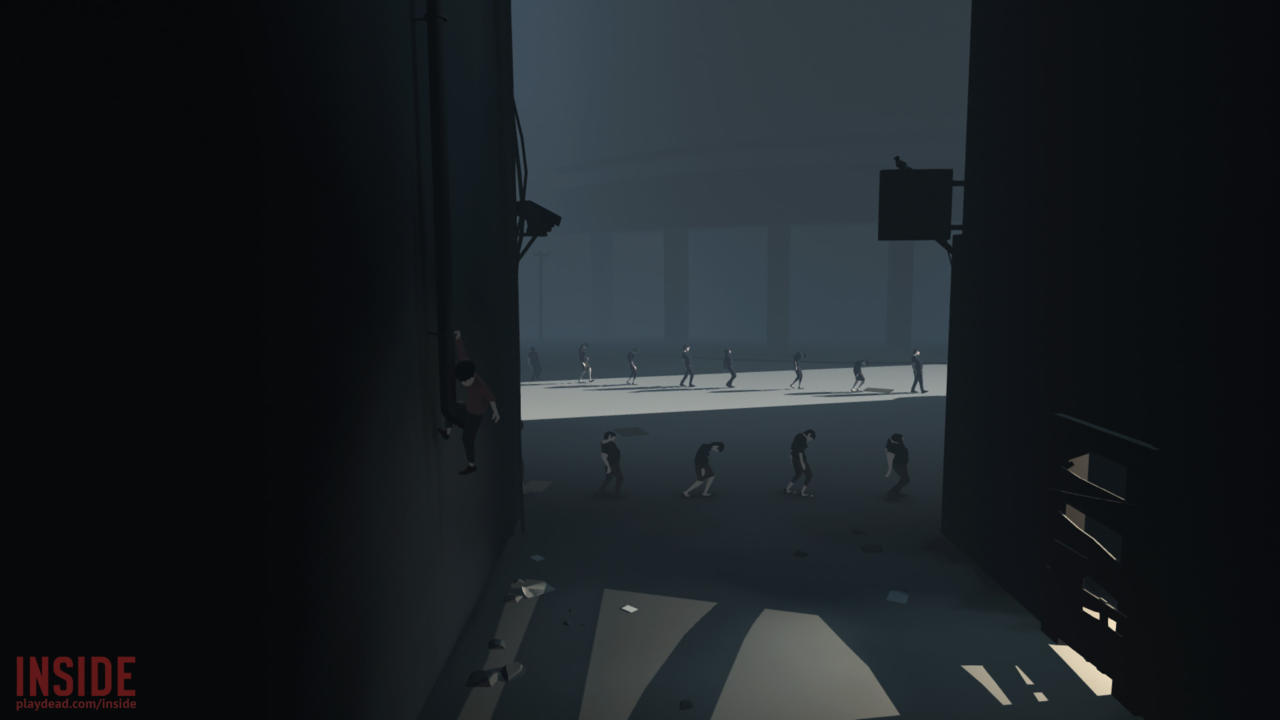There are big expectations for Inside, developer Playdead's follow-up to its highly regarded puzzle-platformer, Limbo. Its debut game was showered with recognition and was both critically and commercially acclaimed, and people lauded it for its exploration of the intersection of life and death; isolation and uncertainty; light and dark.
But Playdead is not content to rehash old themes with Inside. I spent a couple hours playing Inside and discovered that it diverges significantly from the studio's debut. Inside's main character exists within a world gone completely to darkness. Cruelty, slavery, and tyranny fill the decrepit towns and ancient structures. Your character--a nondescript boy--dies or is murdered in a shocking number of ways.
As I played it, Inside's world took every opportunity to deal violence to its main character. It felt old and weathered, weighed down by the monolith of warped civilization. The inhabitants of Inside appeared often in the early moments, with masked, unidentified agents pursuing my character with determined antagonism. Dogs sprinted in pursuit and ruthlessly ripped my character to shreds. Eerie, unexplained machines snatched me away if I happen to be caught in a spotlight.
Cowed and broken citizens shuffled through town, watched by the masked agents. They jumped in unison as the overseers watched. Their identities seemed shorn from them. Occasionally I took control of them, using them to further my journey.

From my short time with Inside, it's this story of a world warped and full of malice that truly defines it. In the early stages, the puzzles I completed fit the settings well: a farmhouse will require you to start up a hulking harvest machine to move forward, whereas a tunnel underneath what appeared to be an abandoned factory will have you operating conveyor belts or cranes. It's easy to draw parallels between the puzzles in Limbo and in Inside, because you still move crates to jump up to higher ledges and you still flip switches to create the perfect sequence of actions. However, many of Limbo's puzzles fit with its focus on nature, emphasizing the power of the forest and the water. Inside's puzzles, on the other hand, seemed unsettlingly artificial, focusing on industrial exploitation and the failure of civilization.
Not surprisingly, as I progressed through the game, the puzzles grew more difficult. Simple obstacles cleared by moving one block or hitting one jump just right gave way to more involved puzzles that required greater exploration and coordination. Nothing got absurdly complicated--Inside won't likely compete with The Witness for difficulty. Some of the puzzles definitely gave me trouble, and it was rewarding to finally clear them when I figured out the trick. Most that I played, however, were fairly straightforward.

But I didn't mind that most puzzles generally took me only a few minutes to solve. I wanted to progress primarily to reveal the next hints of story hidden in each location, and the puzzles felt more like a means to that end than an end in themselves. The game took me through villages, city centers, factories, and buried complexes, and even the oceans and streams hid secrets and paths to explore. During one sequence, I piloted a submarine deep underground and through a buried construct, completing often tense environmental puzzles along the way. It was a welcome break from the normal action.
During gameplay, Inside's sound design played a major part in its impact. Often you'll only hear small noises giving you clues of what is happening in the background. In one scene that lingered with me, zombified figures marched in a rhythmic manner along with a pulsing, ambient noise. It emphasized that these figures were not human anymore, and only existed in the full control of the overlords. Many of the abandoned places I explored often had uncanny, methodical noise beating in the background. Gameplay sometimes became dance-like, forcing me to time each of my moves to a pattern.
Ultimately, the couple hours I spent with Inside left me encouraged and excited to experience its entire story. Playdead found success with Limbo, alighting upon a great balance of ambient sound, stylish art, and mechanics, and the studio's second game is in a similar vein. However, my time with it showed me that Playdead is reaching for a greater and more fully realized world. There was still much of the game left for me to see, but even after my short time with it I was intrigued by its unforgiving world and interesting puzzles. I'm looking forward to spending more time with Inside when it is released on Xbox One.

